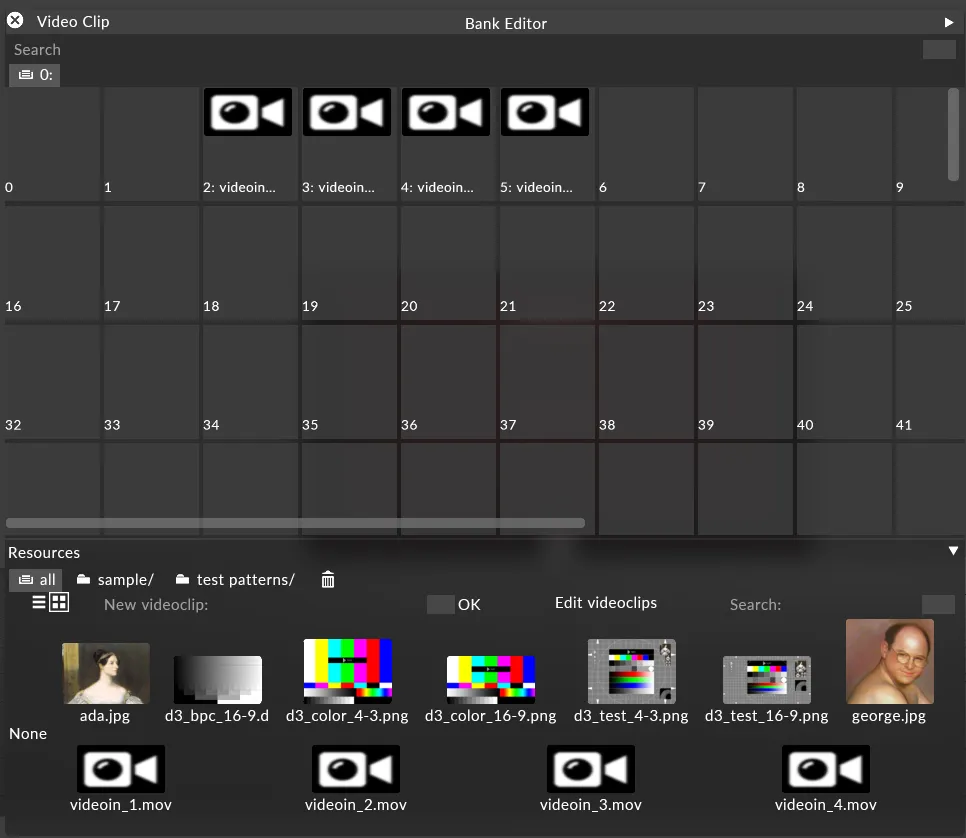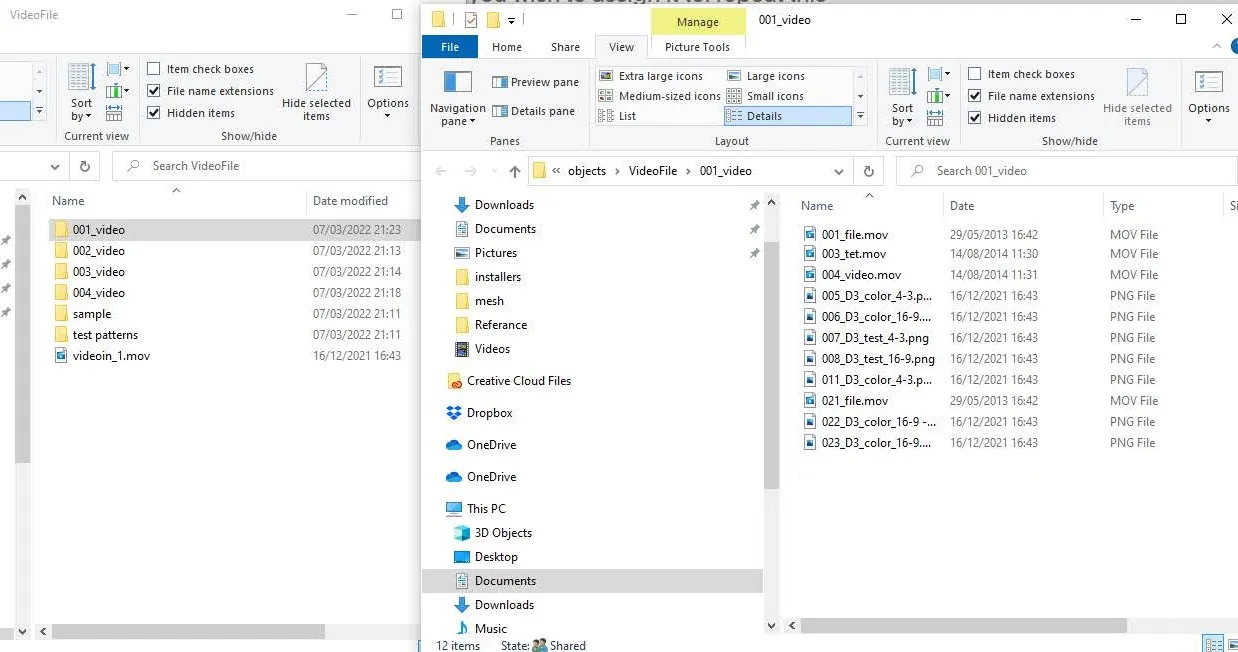Bank Editor
What is the bank editor?
Section titled “What is the bank editor?”The bank editor enables us to assign DMX values to the various resources needed within a layer, examples of such resource parameters include, video or bitmap files, mapping types or HTML bookmarks. This process is managed on a bank and slot basis.
Banks & slots
Section titled “Banks & slots”Within the layer personality, sockpuppet will assign two channels to each resource parameter, the first of these channels will be for the resource bank, and the second will be for the resource slot. For example within the video layer personality, channel 8 is for the video bank & channel 9 is for the video slot.
Example: If we had a video asset assigned to video slot 5 in video bank 3, we would need to output the following from the lighting console to recall it.
channel 8 @ 3, channel 9 @ 5.
This means that we can have a maximum of 255 video banks and within each of those we can have 255 video slots, giving us a total of 65025 assignable video slots (255*255) for each resource type.
Main Interface elements
Section titled “Main Interface elements”To open the Bank editor right-click on the state menu (top left) and underneath the sockpuppet tab left-click “bank”.

At the top of the window we have the currently selected resource type, in this case, video clip. Left click Video Clip to open a menu for other resource types. You can populate the resource bank with resources by dragging them from the resources view in the bottom of the window, to empty bank slots.
Preferences
Section titled “Preferences”The bank editor preferences can be opened by left clicking the small white triangle in the top right corner of the window.
View type
Section titled “View type”Here we can select the way in which we want to view the bank editor. Grid will display the slot window in a grid format and List will display the slot window as a list.
Columns
Section titled “Columns”Specifies the number of columns displayed by default.
Parameter tracking
Section titled “Parameter tracking”By left clicking on this field and setting it to “on” we will have a visual representation of which slot we currently have selected; so as the console programmer scrolls through the slots and banks on the encoders, a red square will be drawn over the slot we currently have selected.
Auto-populate
Section titled “Auto-populate”When disabled, it stops assets being added automatically based on their file name.
Search function
Section titled “Search function”This enables you to search through the assets already assigned to a slot, and will highlight them with a light blue square if they match the search criteria.
Working with banks
Section titled “Working with banks”The banks are all configured and managed in the tabs bar above the slot layout. By default we will have bank 0 already created. In order to open the bank options window right click on an existing bank or on bank 0.
Rename
Section titled “Rename”Here we can specify a custom name for our bank, type it into the field and click ok or press the return key.
Duplicate
Section titled “Duplicate”Here we can copy the contents of our selected bank into another, specify the destination bank number in the field and click ok or press the return key.
New bank
Section titled “New bank”Here we can create a new bank. to do this enter the number for your new bank and click ok or press the return key.
Auto-populate banks from directory
Section titled “Auto-populate banks from directory”Please see below, “under adding assets to slots”
Reset bank
Section titled “Reset bank”This will return the bank to its default state, and empty any populated slots.
Remove missing
Section titled “Remove missing”Allows you to remove missing media from a selected bank.
Delete bank
Section titled “Delete bank”By left-clicking here, we will completely delete the bank from our bank editor.
Adding assets to slots
Section titled “Adding assets to slots”Manually add assets to slots
Section titled “Manually add assets to slots”To manually add an asset to a slot, simply select the resource type you wish to assign, such as textures, left click on the thumbnail in the library and drag and drop it over the slot you wish to assign it to. repeat this process for all of your content. If you have your content organised into files and boxes (click here to read about organising your content) then you can quickly populate your slots with whole boxes at a time. To do this simply hold down Alt on the keyboard and left click over the box you wish to use, this will turn our cursor into a white arrow which we can drag from our box to the first slot we wish to use, release and it will populate the slots with the contents of that box.
Using auto-populate to add assets to slots
Section titled “Using auto-populate to add assets to slots”Another widely used method of assigning DMX values to assets, is adding numerical values to folders and files within your assets library. Designer also supports this workflow and is managed via the auto-populate field in the bank options (see above for how to access).
Auto-populate file structure:
Each of the content folders located within the objects/videofile folder needs to be labelled numerically, for example: 001_Foldername
Files within this folder should follow this same numeric labelling scheme: 001_filename

 Auto-populated results within the Bank Editor
Auto-populated results within the Bank Editor
Creating a directory
Section titled “Creating a directory”When using this method to populate your banks and slots, you will need to start by numbering your folders and files within the project directory in Windows.
Navigate to the resource folder you wish to use (we will be using DxTexture as an example) and number your folders within the DxTexture folder, these will become your bank numbers. Within each of these folders you will need to number your asset files, these will become your slot numbers.
Clearing assets from slots
Section titled “Clearing assets from slots”In order to clear a slot we will need to overwrite it with the “none” thumbnail from our resource library. To do this simply left click on the none thumbnail and drag it over a populated slot. We could also use the reset bank option to clear out the whole bank.
Banks with OSC
Section titled “Banks with OSC”As of r17.3, banks can also be used with OSC sockpuppet.
- The path is always the same: /d3/layer/Typeoflayer/Nameoflayer - Example: /d3/layer/Video/video
- It’s always one message (One address/path + one or two integers)
- Option one: One path and one integer with bank and slot encoded into one number (e,g, bank 1 slot 1 is 256+1=257).
- The formula for a single int is bank255+slot (eg. bank 0 slot 1 is 0255+1)
- Option two: One path and two integers with bank in the first integer and slot in the second integer.